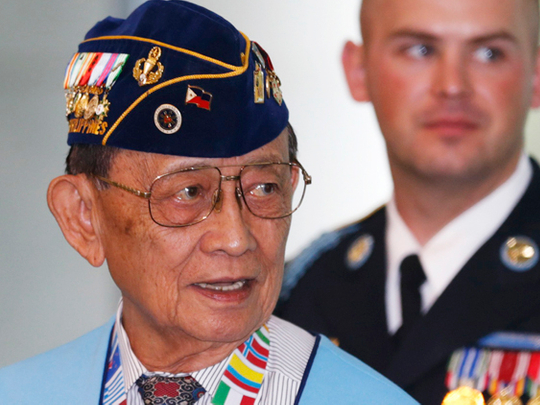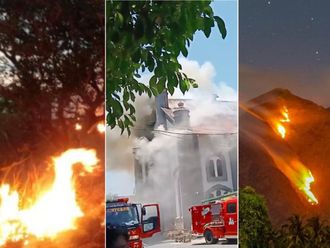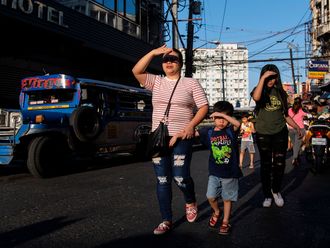
Dubai: Former Philippine President Fidel Ramos may be 85 years old but he can still challenge and beat men 60 years his junior to a gruelling full 50 push-up and sit-up public stint. He may have greyed and have officially stepped out of government office, but he is anything but retired.
Ramos, who has more than five decades of military and government service in his record, continues to hit local news pages today even after finishing his presidential term 15 years ago.
He carries out his advocacy for peace and nation building as the chairman of his own foundation, the Ramos Peace and Development Foundation. He continues to write opinion pieces for local newspapers and abroad.
“I’m still doing my work as a responsible senior citizen. You may retire from your office, from your career, but you never retire from your duties as a citizen of this republic,” Ramos was quoted as saying in an interview with investigative news magazine, NewsBreak.
Born in March 1928 to a diplomat father and a mother who worked as a teacher, Ramos’ career was forged for him early on — public service was in his blood. At 18, he entered the Philippine Military Academy and won a scholarship at the United States Military Academy in West Point.
Always an achiever, Ramos was one of the first four Filipino soldiers to be sent for special forces training in the US, topping the Special Forces-Psychological Operations-Airborne Course at the United States Army Infantry School at Fort Benning.
After graduation, the young lieutenant led a United Nations Filipino Platoon to victory at the Battle of Hill Eerie during the Korean War in 1952.
His next assignment took him to the Vietnam War as a non-combat officer in a purely combat area — which he described later on as his toughest assignment in his military career.
The bemedalled soldier rose up through the ranks — often in combat locally and abroad. Until now, he is the only Filipino soldier who has held all positions in the military from lieutenant to Commander-in-Chief when he became president in 1992.
In 1972, Ramos received full military powers as Chief of the Philippine Constabulary. He was at the beck and call of then strongman and dictator Ferdinand Marcos for 20 years during Martial Law. His loyalty earned him a spot in Marcos’ elite group of trusted advisers, the so-called Rolex 12.
But things took a different turn in 1986 when military support for Marcos—the very foundation on which he bases his power—crumbled. In an apparent attempt to stay in power, Marcos rigged the Presidential elections and the people flooded the streets in protest. This marked the beginning of the four-day People Power Revolution.
Seeing the public outcry against his president, Ramos, together with then Defence Minister Juan Ponce Enrile, defected from Marcos and shifted alliance to the masses. Ramos influence was so strong that he was able to forge the support of the military and police during the bloodless revolt that toppled the dictatorship and sent the Marcoses packing.
From that point on, Ramos became a household name. He was appointed as Chief of Staff of the Armed Forces of the Philippines during the Aquino Administration, crushing seven coup attempts to unseat housewife-turned-president Cory Aquino.
And as if part of a carefully planned strategy, Ramos eyed the presidency after Aquino. His campaign — flooded with his pro-People People Power antics and backed by Aquino — catapulted him to the Presidential Palace in 1992.
Ramos, then the country’s first protestant leader, inherited a nation in disarray and was often branded as a “weak state.”
His term was plagued with recurrent power crises and a weak peso. Investors shun the country due to instability caused by previous military attempts to seize power.
But weakness had no place in Ramos’ administration. For him, the challenge had just begun. The oft-described ‘no-nonsense’ president created an energy department and allowed independent power producers to supply power in the country, solving the power crisis in just two years.
The former man in uniform also campaigned for peace and met head to head with separatist groups in Mindanao. He signed the final peace agreement with the Moro National Liberation Front and gave them conditional powers for an autonomous reign.
Ramos carried out a national reform process and popularised his Philippines 2000 programme through five key targets: peace and stability, economic growth and sustainable development, energy and power generation, environmental protection, and streamlined bureaucracy. After years of pessimism, the people had hope for a better nation was once again, fired up by the president’s ‘We can do this’ attitude.
He opened up the traditionally closed national economy. The globetrotting leader became the most travelled Philippine president and wooed investors abroad. His first three years in power saw the Philippine economy soar. From being the perennial Sick Man of Asia, the Philippines bounced back as the new Tiger Cub Economy of Asia.
But the country’s economic gains were short-lived, the Philippines was not immune to crises after all. The 1997 Asian Financial Crisis hit the country hard, devaluating the peso, closing down business, and rendering people jobless. All this happened with Ramos just having one last year in the Presidential Palace.
Ramos, who, at that time was also faced with corruption allegations, mostly spent his final year as president campaigning for a change in the constitution. Critics said he wanted to extend his term but the Filipino people had already become allergic to apparent Marcos-wannabes. So they trooped to the streets once again and put a lid into Ramos’ dream.
History will remember Ramos as the most competent president after Marcos. His brilliance, leadership qualities, positive attitude continue to lure people to him. His advice on national security and strengthening the economy is still widely-sought out locally and internationally to this day.
He may no longer be actively involved in Philippine governance, but his influence no doubt extends in various political circles, including the country’s movers and shakers. And when the octogenarian is not busy giving his political analyses to the media, he is out there shouting “faster” and making 20-ish men cringe in pain as they race to their 50th push-up.











